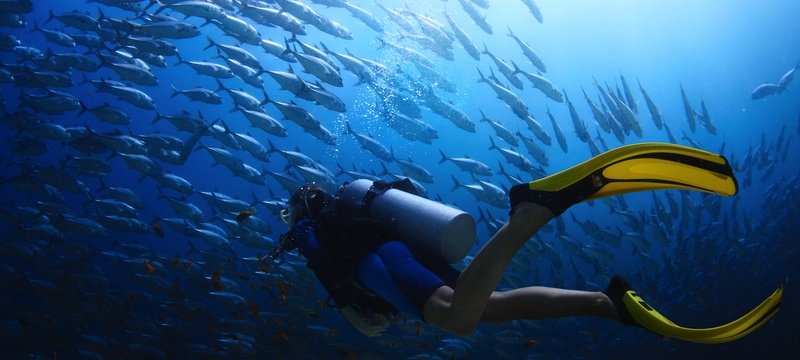In this article we are going to focus on some interesting, previously unknown facts about the oceans and marine life.
Oceans are the driving motor behind life on Earth and mankind. They hold around 97% of the water on our planet and they are very important for our daily lives, since they produce most of the oxygen in the atmosphere.
The World Oceans Day, which is celebrated each 8th of June, is the day when we think about the importance of oceans and how much they mean for us. Each year has a different theme, however, 2013 and 2014 have the same theme, and that is “Together we have the power to protect the ocean.”.
1. Average Temperature
The average temperature in the oceans is around 3.9 ºC. The average temperature at the ocean surface is around 17 ºC, but once you go deeper, the temperature quickly lowers tremendously and can be get values of -2 ºC in the polar seas.
2. Volcanic Activity
90% of all volcanic activity takes place in the oceans, with the highest concentration of volcanic activity being in the South Pacific area. Here you can find more than 1,000 active volcanic cones.
3. Color
The ocean is blue because water absorbs colors in the red part of the light spectrum. So, what is left for us to see are the colors in the blue part of the light spectrum, they are least absorbed by the seawater.
4. Average depth
The average depth of oceans is around 4,267 meters. However, people can’t dive more than 3-5 meters without special equipment as they are subject for water pressure that can bring ear damage and other problems.
5. Highest pressure point
The lower you go in the ocean, the higher the pressure. The highest pressure you can encounter in the deepest points of the earth is around 8 tons per square inch, which is more than enough to squash a person instantly.
6. Deepest point
The deepest point in the sea is the Mariana Trench, which can be found at 10,911 meters under the ocean level. In comparison, it’s more than 2 km deeper than Mount Everest, the highest point on Earth, which is 8,848 meters above sea level.
7. The oceans
The Pacific Ocean, “peaceful sea”, is the largest of the Earth’s oceanic divisions. The second largest ocean is the Atlantic Ocean, the word “Atlantic” refers to Atlas of Greek mythology, making the Atlantic the “Sea of Atlas”. The Indian Ocean is the third largest ocean, followed by the Antarctic Ocean. The Arctic Ocean is the smallest and shallowest of the world’s five major oceanic divisions.
8. Gold
While people have been striving to search for gold on Earth’s surface, there are around 20 million tons of gold buried in the oceans or suspended as particles.
9. Icebergs
Each year the Arctic Ocean creates more than 45,000 icebergs that have a life span of around 4 years. They play an important role in the carbon cycle and also affect how salty the water is in those areas.
10. Longest Coastline
The longest coastline is actually held by Canada, with around 202,080 km.
11. Islands in the Pacific
There about 20,000 to 30,000 islands in the Pacific. Most of these islands are host to unique flora and fauna, which makes them a paradise for any visitor.
12. Speed of sound
Sound travels faster in water than in air, about 4.3 times faster.
13. Tsunamis
Underwater earthquakes are the leading cause of tsunamis. The world’s tallest tsunami happened on July 9, 1958, in Lituya Bay, Alaska and reached around 524 meters (1,720 feet).
14. Air filters
Oceans are a great air filter as they absorb up to half of the carbon dioxide that is produced by burning fossil fuel such as coal or petrol.
15. Pollution
Each year tons of trash are thrown into the oceans, up to three times more than the amount of fish caught in the same period of time.
16. Corals
Coral reefs are estimated to cover 284,300 square kilometers, just under 0.1% of the oceans’ surface area. Unfortunately, coral reefs are dying around the world. The main threats are coral mining, agricultural and urban runoff, pollution (organic and inorganic), overfishing, blast fishing, disease, and the digging of canals and access into islands and bays.
17. Ocean Life
Life in the oceans began around 3.5 billion years ago, but the first land dwellers appeared only 475 million years ago, which is quite recent in the life of our planet.
18. Mangroves
There are about 80 different species of mangrove trees. The mangroves are home to around 85% of all fish you can find in the tropical regions. In the mangroves you can also see beautiful fish species that can’t be found anywhere in the world.
19. Architeuthis dux
Also known as the Giant Squid, Architeuthis dux is the creature that has the largest eyes of an animal on earth. These are up to at least 27 cm in diameter.
20. Darkness
90% of the oceans doesn’t receive any sunlight and is completely dark. This, alongside the high pressure in deep ocean areas is the reason why people explored around 10% of the ocean areas.
In conclusion, the oceans are surely one of the most important and precious resources that mankind have, and by dumping residues into them we are making our life much harder. Instead, we need to focus on protecting them and the marine wildlife, as they are one of the hidden treasures that we can find on Earth.
